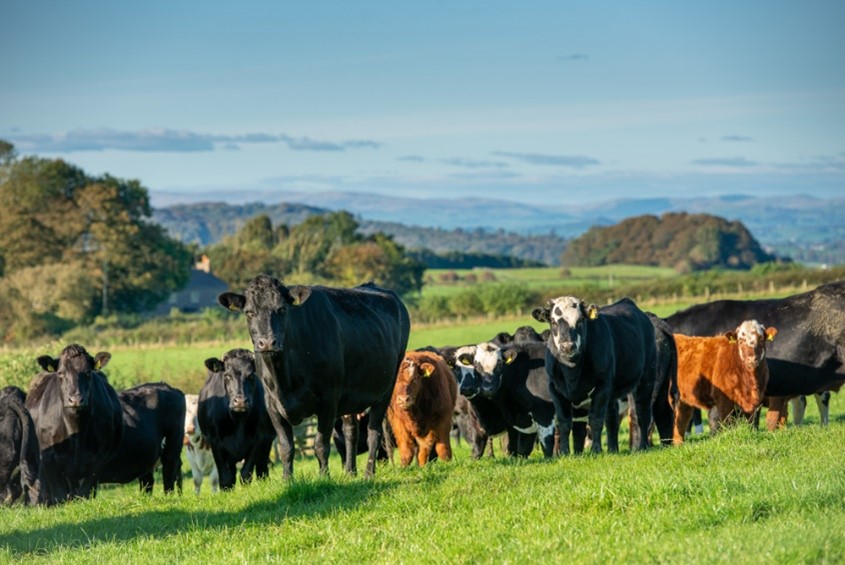Nutrition Planning for Late Summer and Autumn Calvers
5 July 2023This is part of the FAS Beef Technical Toolkit series, designed to give farmers practical timely advice to aid decision-making throughout the year.
The principles of pre-calving nutrition still apply no matter the time of year for calving. As always, cows that have a tight calving period are easier managed, it is virtually impossible when things slip further than 12 weeks to meet the nutritional needs of all cows in the herd at one time.
Cow Condition
Late summer and autumn calvers are traditionally trickier to manage with them being at grass for the last few months of pregnancy when it is often harder to control body condition. Check condition of the cows throughout the winter period when they are housed and feeding is more easily managed. If cows are fatter than you would like to see, take steps to reduce condition in plenty time before calving. This may be putting cows (once weaned) on rougher grazing or keeping the calves on cows longer to reduce condition through producing milk. However, this can be counterproductive as cows will need to be on better grass for the calves (as more than 75% of their nutrition at this stage will come from grazing) and therefore weight loss will be small. If cows and calves are on poorer grazing calf growth rates will suffer if there is insufficient grass – this needs to be considered. For cows calving later in the summer/autumn, keeping calves on cows longer can help reduce the risk of summer mastitis that comes with weaning in the summer months. Calves do need to be weaned at least one month before the calving start date to allow for colostrum production for the next calf.
If there are known later calvers (identified through early pregnancy scanning) graze them on some poorer ground – they are further off calving and have lower nutritional requirements. Save better ground for priority stock, such as the weaned calves. An alternative to this would be to increase stocking density to limit grass intake if no rougher grazing is available.

Low quality baled forage could also be provided if grass becomes too scarce. If grass is bare and straw is fed in ring feeders pre-calving, and if they are eating more than 5kg of straw/day they will need supplemented with additional protein/energy as they will not be consuming enough grass to meet their requirements.
Monitor condition throughout the year and try not to allow big swings in body condition by taking control of rationing and managing grazing pressure as much as possible. One month before calving discovering the cows are too fat is too late and a more proactive approach is needed to managing cow nutrition. It is an easy thing to fix if it is addressed early enough, weight change needs to happen gradually and not by extreme rationing which causes metabolic stress in cows and will do more harm than good.
Mineral Supplementation
Grass is mainly low in trace elements, boluses are a good way of ensuring trace element deficiencies in grass are corrected, however most boluses do not contain macrominerals (like calcium and magnesium) and vitamins so external supplements such as buckets and free-access minerals will address these shortages. Energy, protein and mineral status can all be checked around 1 month pre-calving by metabolic blood profiling through your vet which involves blood testing 5-6 animals. This will allow any nutritional deficiencies to be corrected ahead of the calving period such as low energy, protein or mineral status.
Cows calving on lush grass especially after a dry spell, then rain, are at risk of being low in magnesium. This perhaps doesn’t present as grass staggers, but it can contribute to “Slow Calving Syndrome” where cows lack magnesium to mobilise their own calcium reserves required for uterine contractions and they start calving but struggle to proceed. This can cause calves to lack oxygen, have a poor suckle reflex and colostrum intake with the prolonged calving. Also, although rare in beef cows, there is also the risk of milk fever. This is magnified by the fact that mineral supply to cows at grass relies on cows helping themselves to free access powder or buckets. Grass that is high in potash can reduce magnesium availability in the gut so avoid calving in fields that have had a lot of slurry application or high potassium fertiliser. Correcting a magnesium deficiency at grass can usually be easily sorted, speak to a nutritionist for advice if you encounter this problem.
Make sure that your mineral supplement is high in magnesium when cows are calving at grass. If you have administered a trace element bolus pre-turnout, then trace elements are less important in your external bucket or powder supplement and a suckler cow high magnesium mineral should suffice. Off the shelf pre-calving mineral supplements can often only contain 10% magnesium compared to around 17-20% or more in Hi Mag supplements. Cows need at least 25g of magnesium a day, 30-40g if potassium is high in the grass (as potassium affects the absorption of magnesium). Around half of cows’ magnesium intake will come from the grass (around 10-15g)
Taking time to plan nutrition for cows calving summer/autumn is well worth it to help minimise potential problems over the calving period. Always seek advice from a nutritionist.
Related FAS Materials
Beef Nutrition | Helping farmers in Scotland | Farm Advisory Service (fas.scot)
Written by - Karen Stewart
Sign up to the FAS newsletter
Receive updates on news, events and publications from Scotland’s Farm Advisory Service

